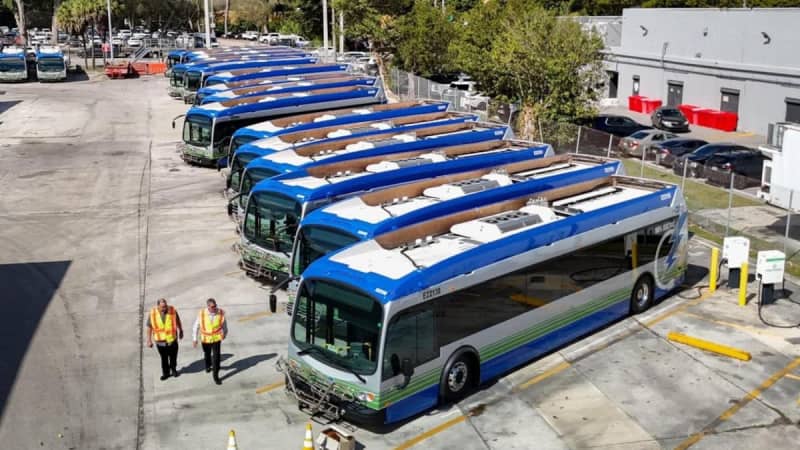Nearly $41 million Florida still has left over from a federal mitigation fund to “replace diesel emission sources with cleaner technology” won’t be used for any more electric bus or electric vehicle charging projects, according to a draft proposal from the state’s Department of Environmental Protection.
Instead, the agency’s pitch is for Florida to use the money to fuel freight trucks with alternative energy sources, like “new diesel” and compressed natural gas.
The draft proposal seeks to shift plans for Florida’s remaining funds from civil settlements reached in 2016 and 2017 between Volkswagen and the Environmental Protection Agency, following the car company’s alleged violations of the federal Clean Air Act. Volkswagen sold nearly 600,000 diesel motor vehicles with devices designed to cheat federal emissions tests for nitrogen oxides, or NOx, according to the settlement.
To offset excess nitrogen oxide emissions from those vehicles with trick “defeat devices,” Volkswagen paid nearly $3 billion into a mitigation trust fund for projects to “replace diesel emission sources with cleaner technology.” States received payouts from that mitigation fund based on how many “trick” vehicles were registered in each state, according to the EPA.
Florida’s total share was $166 million, and so far, most of it has been either spent on or assigned to electric school and transit bus projects. Statewide, 133 electric school buses and 38 electric transit buses funded by the VW settlement money are in operation so far, according to the Department of Environmental Protection.
But the Sunshine State still has nearly $41 million to spend — and if the state’s proposal moves forward, it won’t go toward any additional electric bus projects.
Under the Department of Environmental Protection’s pending draft proposal, Florida also won’t use its remaining VW funds for any more electric vehicle charging infrastructure projects. The draft cites “a range of factors, including ongoing electric vehicle and equipment supply challenges, shifts in federal incentive structures, and the state’s interest in completing its obligations under the Final Trust Agreement as expeditiously as possible.”
South Florida offers an example of the challenges of running EV fleets. Miami-Dade and Broward spent $126 million to purchase 117 electric buses and build charging stations for the new clean, green fleet. It was a forward-thinking solution intended to save South Florida money and cut back on fossil fuel buses that spew pollution and contribute to climate change and health problems.
But the vehicles have been plagued by problems. Earlier this year, reporting by the Miami Herald found that in Miami-Dade, depending on the day, only five to seven of the county’s 69 EV buses are in service. In Broward, none of the county’s fleet of 42 EVs buses managed to run routes earlier this month.
In addition, many federal clean energy incentives are coming to an end under President Donald Trump’s tax-spending package dubbed the “One Big Beautiful Bill Act.” Tax credits reducing the cost of new or used electric vehicles will end on Tuesday.
Meanwhile, the EPA just announced it wants to end “burdensome” greenhouse gas reporting requirements for most large facilities, all fuel and industrial gas suppliers, and CO2 injection sites, where carbon dioxide gets injected deep underground for long-term storage.
Statewide, there are 42 fully operational electric vehicle charging sites funded through the Volkswagen settlement, including 13 in Central Florida, according to the Department of Environmental Protection.
Compared to other states, “Florida has been moving very slowly in rolling these (Volkswagen) dollars out,” said Anne Blair, vice president of policy and freight for the Electrification Coalition. By that token, Blair said it makes sense for the state to try to speed up its spending pace.
But Blair and other clean energy advocates say they’re concerned by Florida’s pitch to avoid spending the state’s remaining VW funds on any more electrification projects.
“(Florida) proposed a suite of alternative fuels that aren’t nearly as clean as electrification. So yes, they will help reduce emissions, but they are still not emissions-free,” Blair said, referencing the “new diesel” and compressed natural gas mentioned in the draft proposal.
Kevin Lofgren is a materials chemist focused on working with renewable fuels. He holds a Ph.D. in chemistry from the University of California, Santa Barbara, where he helped develop a new, simplified way of producing biodiesel.
Biodiesel and renewable diesel are two different things, Lofgren said, although they share some similarities. Both are considered renewable fuels because they’re made from a renewable resource, typically vegetable oil.
“The carbon dioxide that you produce when you burn renewable diesel or biodiesel came from carbon dioxide that the plant absorbed to make the oil in the first place,” Lofgren said. “So it’s just this perfect circle, where you’re not actually putting any new carbon into the atmosphere.”
But that “net-zero” outcome is specific to when the fuel is ultimately burned and used, like when it’s powering an engine, for example. Another key part of the process is production: how the renewable diesel or biodiesel actually gets made.
Biodiesel can be made quite simply, at low temperatures and atmospheric pressures, Lofgren said. But pure biodiesel isn’t typically used to fuel engines; instead, it’s added as a blend, mixed in with traditional diesel made from petroleum.
Meanwhile, producing renewable diesel is “energy-exhaustive” and can create new carbon dioxide emissions, Lofgren said. The production process requires high temperatures, high pressures and use of a metal catalyst, like nickel.
“Renewable diesel is a little bit of a greenwash scam. It’s great for business, not necessarily great for the environment,” Lofgren said. “The temperatures and the pressures it takes to make this stuff is really extreme. And when something’s that energy-exhaustive, you need to put energy into it in the first place.
“As much as I wish that these things were just God’s gift to mankind, they aren’t, and they do have their downsides,” Lofgren said.
Electric vehicles also have downsides. The process of making batteries for EVs is not carbon-free. But over time, compared to a gas-powered car, studies show using an EV throughout its “lifecycle” is still less harmful to the environment.
EVs are also cheaper than vehicles powered by fossil fuels, according to clean energy advocates. “Electrification is a lot less expensive, from a total cost of ownership perspective,” Blair said.
Financially, that gives Florida an incentive to allow for the state’s remaining VW funds to be spent on electrification projects, said Dory Larsen, senior electric transportation program manager for the Southern Alliance for Clean Energy.
“Just in economic rationale, it makes sense to have an electric vehicle option for this program,” Larsen said. “EVs have lower operating and maintenance costs compared to diesel, and they are not as reliant on volatile fuel prices.”
If Florida does remove electrification as an option for using the rest of Florida’s VW funds, it’ll be doing consumers and fleets “a disservice,” Larsen said.
“Fleet operators should have the ability to choose the fuel and the models that they would like to run and operate,” Larsen said. “Eliminating that choice is really like eliminating consumer choice.”
Alexandra Kuchta, communications director for the Florida Department of Environmental Protection, shared a written response to emailed questions about the agency’s pending draft proposal.
“DEP continues to adapt the mitigation plan to ensure Volkswagen settlement funds are allocated effectively, supporting additional eligible projects and delivering meaningful benefits for Floridians,” Kuchta wrote.
This story was originally published by Central Florida Public Media and shared in partnership with the Florida Climate Reporting Network, a multinewsroom initiative founded by the Miami Herald, the South Florida Sun Sentinel, The Palm Beach Post, the Orlando Sentinel, WLRN Public Media and the Tampa Bay Times.








